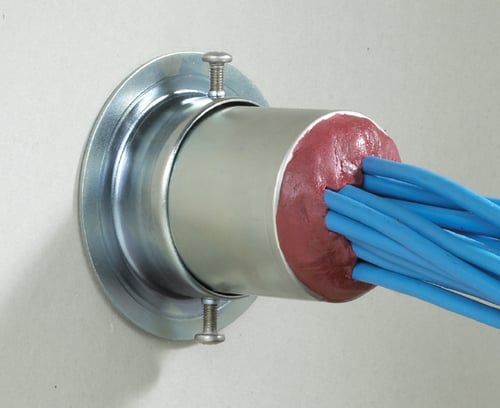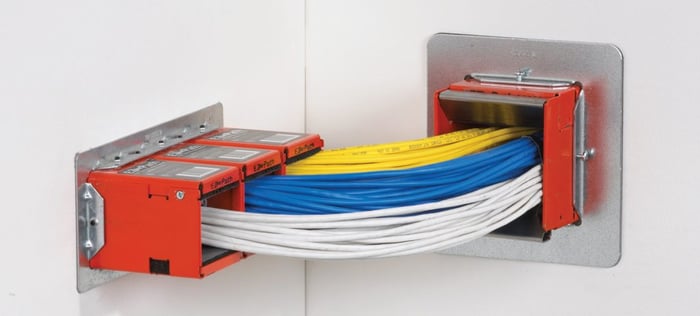Modern Advances in Firestop Technology – New Generation Products Provide Flexibility and Compliance
 Firestopping is a fairly well defined process these days. The average contractor is aware of the need to properly seal penetrations made within fire-rated floors and walls. Not only is it an important step from a life safety and property protection perspective, but it is also code mandated.
Firestopping is a fairly well defined process these days. The average contractor is aware of the need to properly seal penetrations made within fire-rated floors and walls. Not only is it an important step from a life safety and property protection perspective, but it is also code mandated.
Publications such as the BICSI Telecommunications Distribution Methods Manual (TDMM), as well as other BICSI documents, do a very good job of educating designers and installers about the importance of proper planning, design and installation of firestop systems. Still, mention firestopping and most people think of the ubiquitous red caulk applied around cables, conduits and other building service elements passing through fire-rated floors and walls. While firestop caulks or sealants are one product that can be used for sealing penetrations of fire-rated floors and walls, newer generation products have been specifically designed with the cabling contractor in mind. These newer generation products provide maximum flexibility in terms of pulling cable while still meeting all code-related requirements for firestopping.
PREFABRICATED SLEEVE KITS – Prefabricated cable sleeve kits are commercially available. These kits consist of a metal sleeve sized to match the dimensions of a similarly sized section of electrical metallic tubing (EMT) or conduit, metal escutcheon plates to lock the sleeve into place, bushings to prevent cable damage and a pre-metered dose of intumescent (expandable) firestop putty sufficient to firestop each end of the sleeve after cable installation. Additionally, some of the prefabricated sleeve kits also include fire-rated gaskets that are installed behind the escutcheon plate to provide additional fire and smoke resistance. Some prefabricated sleeve kits feature a sleeve with a rolled lip integral to the design of the sleeve. The rolled lip performs the same function as a bushing with the additional benefit of not being able to be removed or dislodged as the cable bundle is pulled through the sleeve. Prefabricated cable sleeve kits are an excellent choice to save on both labor and materials. Additionally, with escutcheon plates locking the sleeve into place compared to conventional field-fabricated sleeves, the sleeve is stable and secure to put up with the rigors of pulling larger cable bundles through. This also ensures code compliance with Section 712.2 of the International Building Code (2006 Edition) where sleeves are required to be “securely fastened to the assembly penetrated.” Section 712.2 also requires both the inside of the sleeve to be sealed, as well as the space on the outside of the sleeve between the sleeve and periphery of the opening. Prefabricated cable sleeve kits with fi re-rated gaskets and a pre-metered dose of firestop putty meet this criterion.
FIRE-RATED PATHWAY DEVICES – While prefabricated cable sleeve kits make the process of code-compliant firestop and sleeve installations easier, fire-rated pathway devices take it a few steps further. A prefabricated sleeve kit still requires the installer to properly install the putty into each end of the sleeve to the required depth. The putty is re-enterable, allowing for future cable moves, additions and changes. However, this creates the potential for the putty to be removed and not replaced or simply not installed properly in the beginning.
 Fire-rated cable pathway devices eliminate this issue. This class of Prefabricated cable sleeve products represents devices that have been specifically engineered for use in environments where frequent cable moves, additions and changes are the norm. These devices
Fire-rated cable pathway devices eliminate this issue. This class of Prefabricated cable sleeve products represents devices that have been specifically engineered for use in environments where frequent cable moves, additions and changes are the norm. These devices
often have the sealing system integrated into the device so that it can never be removed and forgotten. Virtually all pathway products on the market allow for the cable fill to range from zero to 100 percent. So whether a pathway is being installed empty to allow for future use or loaded to full capacity, it will provide full fire protection capabilities.
Many designers and facilities standardize on pathway products that do not require additional steps to maintain compliance. Such products are characterized as zero-maintenance solutions. A zero-maintenance solution should not require any action to activate the fire and smoke protective characteristics of the device. The advantage to these types of products is that the cabling contractor can focus on pulling cable without having to take additional steps to ensure for fire and smoke protection.
Some pathway products are designed to nest very tightly together, while some can even be ganged much like electrical boxes for switches and receptacles. This allows for greater cable capacity while minimizing the size of the opening that needs to be made through a fire-rated floor or wall. While this is clearly advantageous from a structural perspective, there is a commercial advantage as well, particularly for devices installed through floors. In floors, the more cables that can be routed through a relatively compact area, the more usable floor space remains. This can be particularly important in areas where leasing office space is expensive, and tenants wish to have as much usable space as possible for offices and conference rooms. Like the prefabricated cable sleeve kits, most of the commercially available fire-rated pathways include barrier plates to lock the device in place. From the perspective of pulling cables through a device, as well as code compliance with Section 712.2 of the IBC discussed in the preceding sections, the end user is covered. Another benefit of fire-rated pathways is how they ease the inspection process. Unlike caulks or putties and field-erected sleeves, a fire-rated pathway is very easy for an inspector to identify and verify code compliance. Most are uniquely colored to aid in the identification process. Having a fixed loading area also eliminates the need to physically count the number of cables and perform calculations to determine whether the maximum cable loading fill percentage has been exceeded. Most fire-rated cable pathway products can be easily identified from a distance. Furthermore, many devices come with convenient barrier labels that identify additional information such as cable type, installer and appropriate UL Systems.
ESSENTIAL PLANNING – Prefabricated cable sleeve kits and fire rated pathways make the lives of the installer, the inspector and the owner easier by eliminating guesswork and providing a higher degree of probability that a building will be properly firestopped the first time and continue to remain firestopped as time goes by. Good planning up front is always essential, and as good as these products are in terms of removing the element of human error to a degree, a little bit of planning up front makes their use that much more effective.
An important part of the planning process is to determine the number of sleeves or pathways that will be required. It is vital to not only consider the present cabling requirements, but also future growth. A rule of thumb is to calculate sleeve or pathway requirements based on present capacity requirements and then, at a minimum, triple that number. Aside from simply having room for future cabling growth, an additional advantage of having greater capacity is being able to segregate cabling by type or use; or in larger facilities, even by vendor.
With the advent of modern firestopping products, firestopping is no longer a chore best relegated to the least skilled labor on the job. Today’s products provide excellent balance between ease of pulling cables and maximum code compliance.






